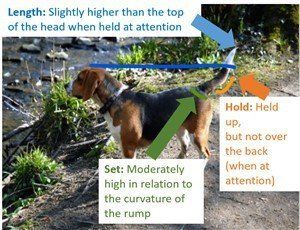Beagle Tails
Overview
Though there are lots of great features about this breed that stand out, including his classic hound colors and drop ears, the tail of a Beagle is among the physical traits that set this breed apart from so many.
Over time, we’ve gathered many questions from Beagle owners regarding a Beagle’s tail and have decided to place all of the Q&A here in one place.
We’ll discuss all tail related topics including:
- Proper length, set and hold including down, tucked and curled tails
- Proper coloring
- Tail injuries
- Itching and loss of fur on the tail, chewing
A painting from the 1800's showing a heavier Beagle, but with that white tipped tail..
Source: Public domain, Author unknown, yet probably Thomas Berwick
Appearance of a Beagle’s Tail – Length, Set and Hold
The Beagle has been bred for centuries to have a certain appearance. Though there are many dogs in the hound
group, only a few resemble a Beagle, making this a nicely unique dog. During the time that groups were working to develop breeds… to make them distinctive and to bring about a standard, certain physical traits were bred in depending on the dog’s purpose. Beagles were bred as scent hounds to track small to medium sized prey such as rabbits, pheasant and sometimes deer. Beagles are quick and have excellent stamina. For this reason, a long, white tipped tail carried high was a preferred trait to allow hunting
parties the ability to spot the dog easily among tall grasses and dense vegetation.
Per AKC and CKC (Canadian Kennel Club) breed standards the tail should be:
Set moderately high; carried gaily, but not turned forward over the back. With slight curve; short as compared with size of the hound; with brush.
Defects-A long tail. Teapot curve or inclined forward from the root. Rat tail with absence of brush.
The FCI (Fédération Cynologique Internationale
– an international federation of kennel clubs with over 80 member countries) has a description of the Beagle’s tail that is slight different (note the length of ‘moderately long’ vs the AKC’s ‘short’): Sturdy, moderately long. Set on high, carried gaily but not curled over back or inclined forward from root. Well covered with hair, especially on underside.
So, let’s look at the most commonly asked questions
we have received in regard to physical attributes of a Beagle’s tail (excluding color of the tail, which we’ll cover next):
How long should a Beagle’s tail be?
This is a common question due, in part, to the confusing vernacular of the AKC breed description. It states the length should be ‘short as compared with the size of the hound’. But Beagles certainly do not have short tails. The FCI more accurately describes a Beagle’s tail with their use of the words ‘moderately long’. When a Beagle stands at attention, his tail length should be slightly higher than the crown of his head (see image below).
This being said, there are lots of Beagles with slightly shorter tails and some with very long tails. While those dogs would lose points in the show ring and if the tail is very short or exceedingly long, the dogs should most likely be kept from a breeding program, a Beagle’s tail does not need to be ‘perfect’.
What is the right Beagle tail set?
The set of a tail is where the base connects to the dog’s rump. In other words, looking at a Beagle from the side, the area on the curvature of his rump where the tail emerges is its set (see image). The tail set of a Beagle is ‘moderately high’ per the AKC and ‘high’ per the FCI.
How Should a Beagle hold his tail?
Beagles hold their tails many different ways. Down, up and flopping all over. All standards agree that it should be carried ‘gaily’ which means happily yet casually. This does refer to when the dog is at attention. The tail should have a slight curve, but not so much that it is carried over the dog’s back.
This being said, Beagles are often very animated with their tails and will hold them at varying angles, depending on their mood and actions.
If a Beagle is relaxed he may hold his tail down, he may sleep with it curled and tucked around his body and there are times when a Beagle may curl his tail, carry it close to his back or have it pointing down to the ground… all sorts of odd angles. The only time to be concerned is if a Beagle can’t hold his tail up or shows signs of pain
when trying to do so (more ahead).
Unless the dog is at attention, he should not be judged on how he holds his tail, it will vary all throughout the day.
Molly at 2 and 1/2 years old
Photo courtesy of Marlyn Black
My Beagle holds his tail over his back, what does this mean?
As with most elements in standards, the attribute of a Beagle ‘never’ holding his tail over his back refers only to what the ‘perfect’ dog will look like in the ring. While many Beagles do not curl their tail over their back, some will. The tail may be set higher and/or the tail may be longer compared to other Beagles. It is a fault in show and a tail should be taken into consideration if breeding is being considered, however for a family pet, this is just fine.
My Beagle’s tail is curled, what does this mean?
While most Beagle’s will have a slight curvature of the tail and may hold the tail straight at times, some have much more of a curve than the ‘ideal’ Beagle expected to prance around in the show ring.
This by itself does not mean that the dog is not a purebred or that there is anything wrong at all. As with most tail shapes, lengths and holds, the only time to be concerned is if there is a change and the Beagle cannot hold his tail as he naturally would otherwise (more ahead).
My Beagle is holding his tail funny/ in an odd way
If you take the time to really study a Beagle all throughout the day, you’ll definitely see times when the dog is briefly holding his tail at a funny angle or in a way that seems odd. However, in most cases this is just due to the dog’s mood or the activity that he is engaged in.
A Beagle may hold his tail down if he is feeling depressed or scared. Sometimes, the tail will go down due to submission and this can most certainly happen if a Beagle is being scolded by his owners.
There are 3 conditions that may cause a Beagle to hold his tail oddly (excluding actual injury to the tail itself):
1.
Engorged anal glands. These small peanut sized glands (one located on each side of the anus), hold oils (commonly referred to a scent oils). Minuscule amounts are released when one dog encounters another and some is also released when the dog has a bowel movement. Sometimes, the oil will build up, causing the glands to become enlarged. This can cause somewhat intense itching (the dog may scoot his/her bottom along the ground in an attempt to relieve the itching).
Normally 1 of 3 things will happen: The oil may be reabsorbed (in which case the swelling goes down), the skin may break open due to the tight pressure (in which case a quite noxious odor
will be released along with the fluid – this should be looked at by the vet so that the tear can be treated and skin is not left open and vulnerable to infection) or a vet or groomer may express the glands.
2.
Back problems – Since the tail is a continuation of the spine, issues in the back can radiate down into the tail. This includes pain due to a ruptured disk and other back pain issues.
3.
Age related posture – As a Beagle ages, he loses some muscle and tendons may weaken. In addition, arthritis comes into play as well. All of these issues may cause an older, senior Beagle
to have what appears to be a weakened tail hold.
As with all holding and movement issues, you will want to make sure that the tail has not been injured and that it is just a matter of the Beagle choosing to hold it in an odd way as opposed to not being able to move it or hold it as he normally does (more ahead on tail injuries).
Tail Color
The fact that a Beagle should have a white
tipped tail is so ingrained in owner’s minds that we have received several emails from worried owners whose Beagle has only a tiny bit of white or a color that may be considered off white.
So, is it true that all Beagles have white tipped tails? The answer is yes, all Beagles do and in some rare cases the white will be so minor that it may be difficult to see.
The element of the tail tip being white is known as the flag. As mentioned earlier, this is coloring was purposely developed to allow those in charge of Beagle hunting packs to see the dogs as they chased after prey in fields of tall grasses and other such landscaping where it would otherwise be difficult to keep track of a dog.
In regard to a Beagle’s white tipped tail being an off-white or cream color, this has actually come up a time or two. In one case, this was a matter of a brand new puppy
not yet having a bath (this was not the fault of the owner); dirt and fine particles had accumulated on the pup (though he appeared to be clean) and once he was thoroughly scrubbed down, his white tail tip was a nice snowy white. (See the before & after photo to the right on computer & below on mobile)
In the other case, it was a matter of the pup having mottling on the tail (spots of color) that blended in other colors. As the Beagle matured, white increasingly appeared on the tail until he had a good inch or so as an adult.
This leads us to the common question of how much white should a Beagle’s tail tip have? There is actually no preferred length though the white should be visible without having to inspect it; a Beagle with 1 inch of white vs half the tail being white will be judged the same in the ring.
Light colored Beagles (lemon, lemon-white or tri lemon, white, tan) may have full white tails.

The cute little Beagle puppy had a tan/cream tipped tail (on top of the white). Was this a color defect? No! After his very first bath, the tail was perfectly snow white!
Pluto
Photo courtesy of Madhu Singh Das
Beagle Tail Injuries
A dog’s tail is prone to injury since it is moderately long and can be stepped on, caught in a closing door, etc. The tail can also be injured due to fast whipping (such as when a dog shakes himself dry) especially if the tail is thumped or whacked against a hard surface such as a wall. Consisting of bones from the base to the tip, the tail can be bruised, sprained or even broken. One sort of tail injury happens with seemingly harmless events though its causes are up for debate, so we will cover this as well.
Beagle Tail / Limber Tail Syndrome– This condition has a lot of nicknames given by vets, including swimmer's tail, cold water tail, cold tail, broken tail, dead tail, rudder tail and broken wag. With this, the tail goes limp. Essentially, this is a bruising of the tail with muscle damage towards the base. It can be misdiagnosed as a sprained tail.
It is found mainly with hunting/hound dogs, the Beagle included.
Signs:
1 of 2 things may happen:
1.
The tail goes limp. The Beagle may be able to hold it up just a bit, but then it falls back down. The dog does appear to be in pain, often whimpering and laying down in such a way to show that he is in distress.
2.
The tail will hold out horizontal 2 to 4 inches, but then drop vertically. Essentially, what appears to be a ‘broken tail’.
This is an acute condition that suddenly happens and therefore not one in which the tail got progressively worse as time went on.
What causes this:
While ‘swimmer’s tail’ is one of the terms used to describe this and some dogs do develop this after swimming, a dog does not need to enter into a body of water for this to happen.
Alfie at 4 and 1/2 years old
Natalie
In most cases, this is caused by overexertion (the tail is used for balance and with excess exercise, it is overused and therefore muscles are damaged) and this can be from something as innocent as taking your Beagle for a long run. This condition is rare and owners are encouraged to exercise their dogs as usual. As with all exercise, just do not allow your Beagle to overdo things.
Some veterinarians have seen this happen after confinement (in a crate for more than 8 hours) or from a sudden temperature change (example: the body gets hot from running and then quickly cold from jumping into a pool or even just from a cold bath, hence the swimmer or cold water tail terminology).
With some Beagles that develop this, other health conditions
will be discovered once the dog is examined. Such issues as degenerative disk disease or incontinence (urinary or fecal) may be present.
Treatment:
It is recommended to have this treated as soon as possible, as it is often very painful for a dog. Once diagnosed, anti-inflammatory medication is often given and this is usually in the form of a cortisone shot. It will help with the pain as well. In many cases, a mon-steroidal anti-inflammatory medication will then be given for several days. Rimadyl or Deramaxx is commonly used.
The Beagle will need to rest to allow the muscles to heal. During this time, it’s best to keep the dog inside and do not exercise him.
Barnaby, 8 months old
Photo courtesy of Christine S.
Recovery time: Luckily, most dogs make a full recovery and it takes up to 2 weeks for a Beagle to recover from limber tail syndrome. Once the tail is moving as usual, take things easy for the next couple of weeks.
Injury/ Trauma
– The list of accidents that can happen that injure a dog’s tail is endless. Owners accidentally step on dogs tails quite a bit, they can be caught in car doors, house doors or even playing too rough with another dog can cause injury.
This said, many Beagles with a hurt, sprained or even broken tail receive the injury when no one is looking: they may thump it hard into wall or around a corner. This leaves owners wondering why in the world the tail is suddenly kinked, or being held funny and the dog is showing signs of pain.
Diagnosis and Treatment
– The vet will examine the tail, check the spine and take x-rays. Since the tail consists of bone, either a bruise, sprain or break will be determined. Anti-inflammatory medication will be given, which also helps with pain. In most cases, rest ranging from 2 to 6 weeks will allow the tail to heal. Often even breaks will heal on their own without a need to set the tail; however, if the fracture is at the base, surgery may be needed to prevent nerve damage.
Itchy Tails / Fur Loss
When a dog has itchy skin, he’ll chew at what is most accessible, and for this reason if a Beagle is experiencing a problem that is causing an intense itch, he will most often chew at his tail or his paws. Dry skin in itself can cause peeling that leads to thinning fur. If you add on the damage that chewing causes, this can lead to cracked skin, bleeding, sores and even balding areas on the tail.
It is important to have the cause of the itching diagnosed. Most often, it will be some sort of an allergy. This can be a contact allergy (something the dog touches) however in most cases it will be a food allergy or airborne allergy.
In regard to food allergies, while a dog may be allergic to an actual food, in most instances it is a matter of the dog’s body reacting to a chemical in his food. This can be artificial coloring, preservatives and/or flavoring. The cheaper the food, the more chemicals are packed into it.
A veterinarian can determine the triggers, which can then be avoided and additionally prescribe antihistamines and possibly anti-inflammatories. Broken skin may need to be treated as well, to prevent infection.
Exceedingly dry skin can also develop in the winter, when air is cold and dry. You can take steps at home to help with this by bathing your Beagle with moisturizing shampoos, using a leave-in spritz that helps the skin and coat retain moisturize and running humidifiers in the house to help combat arid winter air.
Sioux at 20 months
Photo courtesy of Mark & Margo
Compulsive Chewing of the Tail
If a Beagle obsessively chews at his tail, particularly the tip of it, and health conditions are ruled out, this can be a matter of obsessive chewing. In many cases it is a self-coping mechanism to deal with stress, though some dogs will chew their tail due to boredom.
For this reason, owners may realize that this is only happening when the Beagle is home alone or if someone is home, when attention is not given to the dog.
It can be tricky to stop this sort of habit. Since stress can cause this, taking steps to combat separation anxiety is often needed. This includes such things as making sure the dog is confined but not in such a small space as to cause a claustrophobic response. A gated off area is best. Experiment with a window vs a non-window view. A radio or TV playing in the background can help a dog feel as though his has company and obtaining a companion toy (those that emit a soothing heartbeat and warmth) can be comforting as well.
Leaving lights on, a shirt with your scent and even herbal calming supplements can help with Separation Anxiety
as well.
If a Beagle chews at his tail due to boredom, adding in an extra walk each day and a window of one-on-one play time can help a great bit. In addition, toys should be reassessed; throw away what is being ignored and obtain several select toys that engage and encourage interaction.

-243x204.dm.edit_PxDVDd-1920w.jpg)









